#fwaas2017
Explore tagged Tumblr posts
Photo
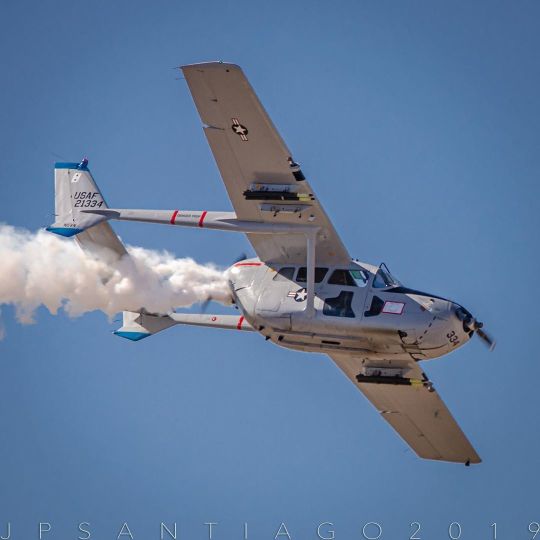
To the military brass in Vietnam, the forward air controller (FAC) pilots were the biggest bunch of miscreants to ever fly a USAF aircraft. To the boots on the ground, they were a guardian angel with eyes up above that could summon air strikes. And to the pilots of the fast movers that hit targets marked by the FACs, they had big brass balls to fly low and slow using the Mark One eyeball to ID targets. ⠀ ⠀ The USAF procurement of the Cessna O-2 Skymaster came out if a need for a more capable forward air control platform in Vietnam than the O-1 Bird Dog. Having twin engines have it a measure of redundancy when flying low over the battlefield in the FAC role, but it also allowed the O-2 more performance in the tropical air in Vietnam as well as being able to carry more weapons. The USAF would procure 532 O-2 Skymasters. In Vietnam, the Skymaster had two nicknames- “Oscar Deuce” and “Duck”. ⠀ ⠀ The first O-2 Skymasters flew with 7.62mm Minigun pods underwing, but aggressive O-2 pilots were taking matters into their own hands attacking targets and O-2 losses climbed. So the gunpods were banned and white phosphorus target marking rockets were carried. But the O-2 pilots, being a scruffy and resourceful bunch, took their M16s with them and fired them out the side windows. Ejected shell casings were dinging the rear prop, damaging the instrument panel and messing with radios. So the M16s got banned. ⠀ ⠀ Not ones to give up, the FAC pilots (as one pilot said, “We’ll FAC anything!”) took to using their service pistols and hand grenades to keep the enemy occupied until the fast movers arrived. ⠀ ⠀ Of the 532 O-2 Skymasters built for the USAF, 82 were lost in combat. Seven O-2 drivers earned the Distinguished Flying Cross in Vietnam. ⠀ ⠀ November Aviation Photo Challenge | @kjdphoto1971 | #1119planes | “Air Force” | Day 26⠀ ⠀ #Avgeek #aviation #aircraft #planeporn #KAFW #AFW #AllianceAirport #FWAAS2017 #airport #planespotting #Cessna #O2 #Skymaster #USAF #FAC #instagramaviation #aviationlovers #aviationphotography #mil_aviation_originals #instaaviation #aviationlovers #aviationphotography #flight #AvGeeksAero #AvGeekNation #AvgeekSchoolofKnowledge (at Fort Worth Alliance Airport) https://www.instagram.com/p/B5VQ14ThOV8/?igshid=5iy13z6rz0fc
#1119planes#avgeek#aviation#aircraft#planeporn#kafw#afw#allianceairport#fwaas2017#airport#planespotting#cessna#o2#skymaster#usaf#fac#instagramaviation#aviationlovers#aviationphotography#mil_aviation_originals#instaaviation#flight#avgeeksaero#avgeeknation#avgeekschoolofknowledge
60 notes
·
View notes
Photo

The origins of the Skyraider were born out of the eventual wind down of the production of the equally legendary Douglas SBD Dauntless dive bomber. ⠀ ⠀ With production ending on the Dauntless in 1944, Douglas made three attempts in a short period of time to stay in the carrier aircraft business. The first one was the SB2D Dauntless II which first flew in 1943 which had a tricycle undercarriage, cranked gull wing and an internal bomb bay. Only 30 were built and was too heavy among other design specs it failed to meet on account of the Navy changing its requirements midway during the program. ⠀ ⠀ The SB2D was redesigned as the BTD Destroyer but it failed to win over the Navy with its designer, Ed Heinemann, advocating its cancelation. ⠀ ⠀ There was also the very large TB2D Skypirate torpedo bomber that could only be flown from the Essex and Midway class carriers, but the end of the war in Japan meant only two Skypirates were built.⠀ ⠀ Not wanting the SBD Dauntless to be the end note of Douglas naval aircraft, an all-new lighter and more versatile design came about as the BT2D with funding from the cancelation of the BTD Destroyer and it assumed the name Dauntless II from the abortive SB2D.⠀ ⠀ By 1946 Navy had consolidated the scout bomber (SB), torpedo bomber (TB) and bomber torpedo (BT) roles into a single “A for Attack” designation. Squadrons in the carrier air group were also consolidated with bombing squadrons (VB) and torpedo squadrons (VT) becoming attack squadrons (VA). ⠀ ⠀ The BT2D Dauntless II was redesignated *and* renamed as the AD Skyraider and the its success cemented Douglas’ place on carrier flight decks for years to come.⠀ ⠀ As a side note, it was in 1963 that carrier air groups were renamed carrier air wings. ⠀ ⠀ #Avgeek #aviation #aircraft #planeporn #KAFW #AFW #AllianceAirport #FWAAS2017 #airport #planespotting #Douglas #AD #A1 #Skyraider #instagramaviation #aviationlovers #aviationphotography #mil_aviation_originals #instaaviation #aviationlovers #aviationphotography #flight #AvGeeksAero #AvGeekNation #AvgeekSchoolofKnowledge (at Fort Worth Alliance Airport) https://www.instagram.com/p/B5QpvVkBokG/?igshid=1rsi280x5khwq
#avgeek#aviation#aircraft#planeporn#kafw#afw#allianceairport#fwaas2017#airport#planespotting#douglas#ad#a1#skyraider#instagramaviation#aviationlovers#aviationphotography#mil_aviation_originals#instaaviation#flight#avgeeksaero#avgeeknation#avgeekschoolofknowledge
14 notes
·
View notes
Photo
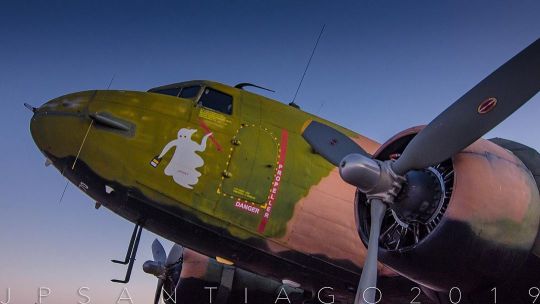
Yeah, I know the Day 14 theme is “Fighter” in the Aviation Photo Challenge, but hear me out as to why I’m submitting an AC-47 Spooky as a fighter. Trust me, it’s a great historical side note in the history of Air Force gunships. ⠀ ⠀ The Douglas AC-47 Spooky gunship was the grand-daddy of a whole unique class of combat aircraft that came into existence in Vietnam. The first AC-47 gunships were converted at Bien Hoa AB in-theater with conversion kits created by the Air Force’s Aeronautical Systems Division. ⠀ ⠀ Two aircraft were converted as a proof of concept with three 7.62mm Miniguns, a Mark 20 Mod 4 gunsight from A-1 Skyraider mounted on the pilot’s left cockpit window, VHF, UHF, and FM radios, TACAN equipment for navigation, IFF gear, 45 flares, each producing 20,000 candlepower of illumination and over 24,000 rounds of ammunition for the Miniguns.⠀ The new gunships were designated FC-47 (FC for “Fighter, Cargo). Aeronautical Systems Division crews flew the first two FC-47s on 54 combat missions where they were decisive in breaking Viet Cong night assaults. ⠀ ⠀ Not long after those first two prototype FC-47s were flying combat missions, the fighter pilots on the command staff of Seventh Air Force and the Pacific Air Forces which were in command of USAF assets in Southeast Asia, heard about the FC-47 designation and nearly lost their minds over transport aircraft that were built during World War II with “F” for fighter designators. In the interests of keeping the peace and avoiding an internecine fight within the United States Air Force, the FC-47 was redesignated the AC-47, spawning an entire new class of combat aircraft.⠀ ⠀ November Aviation Photo Challenge | @kjdphoto1971 | #1119planes | “Fighter” | Day 14⠀ ⠀ #Avgeek #aviation #aircraft #planeporn #KAFW #AFW #AllianceAirport #FWAAS2017 #AllianceAirShow2017 #airport #planespotting #Douglas #DC3 #AC47 #Spooky #USAF #instagramaviation #aviationlovers #aviationphotography #mil_aviation_originals #instaaviation #aviationlovers #aviationphotography #flight #AvGeeksAero #AvGeekNation #AvgeekSchoolofKnowledge (at Fort Worth Alliance Airport) https://www.instagram.com/p/B43ebtTBUQR/?igshid=8wmue5xdou6d
#1119planes#avgeek#aviation#aircraft#planeporn#kafw#afw#allianceairport#fwaas2017#allianceairshow2017#airport#planespotting#douglas#dc3#ac47#spooky#usaf#instagramaviation#aviationlovers#aviationphotography#mil_aviation_originals#instaaviation#flight#avgeeksaero#avgeeknation#avgeekschoolofknowledge
11 notes
·
View notes
Photo
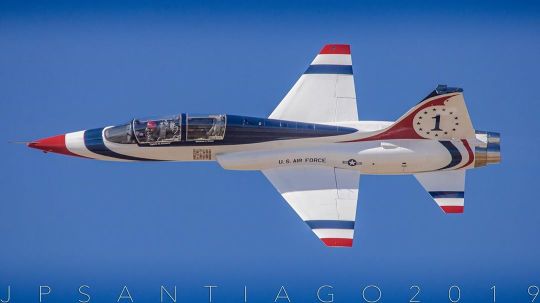
The Thunderbirds converted from the Talon to the F-16 in 1982- the only thing missing from H. Ross Perot Jr.’s T-38 that would make it an accurate representation of a Thunderbird Talon is a shark fin VHF antenna on the dorsal fuselage behind the cockpit. I believe the flag panel on the forward fuselage is accurate for the 1980 show season. Perot Jr’s T-38 is named “The Spirit of Alliance” as his real estate development company, Hillwood, was the driving force behind the construction and development of Fort Worth Alliance Airport. When flying at air shows it uses the call sign “Spirit 1”. The first time I saw the Thunderbirds as a kid was their last season with the F-4 Phantom but most of what I remember was the Talon show. It didn’t have the roar of the Phantom or the glitz of the Fighting Falcon, but the Talon was a sleek jet and the stylized “stinger” scheme on the underside accentuated that. Given the Talon’s small wings, the usual stylized Thunderbird motif wasn’t used again until the team converted to the Fighting Falcon in 1982. The amount of fuel used by the six-jet Talon team was equal to the fuel used by a *single" Thunderbird Phantom during a show. Given the fuel prices of the early and mid-1970s, the conversion to the Talon was quite a boon to the bottom line not to mention the ease of maintenance for the Talon compared to the Phantom. Not to mention the recruiting value that neophyte pilots for the USAF would train in the very aircraft that the Thunderbirds flew. I never get tired of seeing this jet in action. Along with the Blue Angels A-4 Skyhawk, this was a big part of my air show experiences as a wee fart. November Aviation Photo Challenge | @kjdphoto1971 | #1119planes | “Jet Trainer” | Day 4 #Avgeek #aviation #aircraft #planeporn #KAFW #AFW #AllianceAirport #FWAAS2017 #AllianceAirShow2017 #airport #planespotting #Northrop #T38 #Talon #Thunderbirds #Spirit1 #SpiritofAlliance #RossPerot #instagramaviation #aviationlovers #aviationphotography #mil_aviation_originals #instaaviation #aviationlovers #aviationphotography #flight #AvGeeksAero #AvGeekNation #AvgeekSchoolofKnowledge (at Fort Worth Alliance Airport) https://www.instagram.com/p/B4bwspDhXm9/?igshid=1apr3bjk86x8z
#1119planes#avgeek#aviation#aircraft#planeporn#kafw#afw#allianceairport#fwaas2017#allianceairshow2017#airport#planespotting#northrop#t38#talon#thunderbirds#spirit1#spiritofalliance#rossperot#instagramaviation#aviationlovers#aviationphotography#mil_aviation_originals#instaaviation#flight#avgeeksaero#avgeeknation#avgeekschoolofknowledge
12 notes
·
View notes
Photo
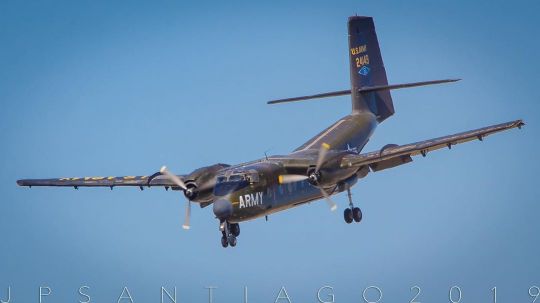
The De Havilland Canada DHC-4 Caribou was the company’s first twin and was just as rugged as the Otter and Beaver- despite the size increase, the Caribou had outstanding field performance on account of its full span flaps, the outer sections of which also acted as ailerons. Of the 307 built, 165 went to the US Army who used them extensively in Vietnam- 20 were lost in combat.⠀ ⠀ Despite the protests of the USAF, the Army deployed the CV-2 Caribou. When airlift was needed in South Vietnam, the USAF blocked the CV-2s and sent their own C-123 Providers instead. ⠀ ⠀ Under the guise of supporting Army facilities in Thailand, the CV-2 was deployed there instead and then sent to Vietnam for “test purposes”. They never left and their extreme STOL capabilities made them useful for supplying remote fire bases and special forces camps. The Caribou’s extensive flaps made airstrips as short as 1000 feet in length accessible.⠀ ⠀ You’ve probably seen the movie or read the book “We Were Soldiers” about the set up of the First Cavalry Division (Airmobile) under Colonel Hal Moore and going to combat at the Battle of Ia Drang Valley in 1965. Several CV-2s were attached to the 1st Cav as logistical support for the division’s helicopters. ⠀ ⠀ There’s a misconception that the USAF co-opted the Caribou fleet from the Army- fact is, Ia Drang showed the Caribou’s limits- the Hueys required a lot of fuel to sustain combat operations and a Caribou could only carry two 500-lb fuel bladders while the C-130 Hercules could carry fourteen. ⠀ ⠀ General Harold Johnson, the Army Chief of Staff, wasn’t pleased and the Caribous were transferred to the USAF in 1966 as the C-7A in exchange for USAF assent in letting the Army develop heavy lift helicopters like the CH-47 Chinook. ⠀ ⠀ November Aviation Photo Challenge | @kjdphoto1971 | #1119planes | “Army" | Day 23⠀ ⠀ #Avgeek #aviation #aircraft #planeporn #KAFW #AFW #AllianceAirport #FWAAS2017 #airport #planespotting #DeHavilland #DHC4 #CV2 #C7 #Caribou #instagramaviation #aviationlovers #aviationphotography #mil_aviation_originals #instaaviation #aviationlovers #aviationphotography #flight #AvGeeksAero #AvGeekNation #AvgeekSchoolofKnowledge (at Fort Worth Alliance Airport) https://www.instagram.com/p/B5NgFzJhiWH/?igshid=1294x2z8zyk27
#1119planes#avgeek#aviation#aircraft#planeporn#kafw#afw#allianceairport#fwaas2017#airport#planespotting#dehavilland#dhc4#cv2#c7#caribou#instagramaviation#aviationlovers#aviationphotography#mil_aviation_originals#instaaviation#flight#avgeeksaero#avgeeknation#avgeekschoolofknowledge
6 notes
·
View notes
Photo

C-17 Globemaster III basking in the tarmac floodlights before sunrise at Fort Worth Alliance Airport. ⠀ ⠀ The McDonnell Douglas (Boeing) C-17 was influenced by the earlier YC-15 program which achieved STOL performance by what are called “externally blown flaps” (EBF). Basically the jet exhaust blows onto double slotted flaps, dramatically boosting their effectiveness. The massive externally blown flaps on the C-17 are titanium skinned for heat resistance from the exhaust of the Pratt & Whitney F117 turbofans (military versions of the PW2037 used on the 757). ⠀ ⠀ Now get out your AvGeek School of Knowledge notebooks. ⠀ ⠀ The lift coefficient relates basically three factors for a wing- the lift force, the dynamic pressure, and the wing area. ⠀ ⠀ The lift force is the amount of force that a wing has to create to overcome weight. For a plane to takeoff, the total lift force has to be more than the weight. ⠀ ⠀ The dynamic pressure is the force created by a wing in motion. It’s one-half times the velocity squared. So a wing generates more lift with more speed since the dynamic pressure is higher. That’s why wings stall at slow speeds. ⠀ ⠀ And the wing area is obvious- more wing, more lift. ⠀ ⠀ On the C-17, the exhaust from the F117 engines and those big externally blown flaps deployed nearly doubles the lift coefficient of the C-17’s wing! The exhaust blowing across the flap system increases the dynamic pressure which in turn increases the lift force- the flaps basically think they’re going faster than they really are and that’s the key to the outstanding field performance of the C-17.⠀ ⠀ #Avgeek #aviation #aircraft #planeporn #KAFW #AFW #AllianceAirport #FWAAS2017 #airport #planespotting #McDonnellDouglas #Boeing #C17 #Globemaster #USAF #instagramaviation #aviationlovers #aviationphotography #instaaviation #aviationlovers #aviationphotography #flight #mil_aviation_originals #AvGeeksAero #AvGeekNation #AvgeekSchoolofKnowledge (at Fort Worth Alliance Airport) https://www.instagram.com/p/B53nriSBREF/?igshid=1y073prxjdmio
#avgeek#aviation#aircraft#planeporn#kafw#afw#allianceairport#fwaas2017#airport#planespotting#mcdonnelldouglas#boeing#c17#globemaster#usaf#instagramaviation#aviationlovers#aviationphotography#instaaviation#flight#mil_aviation_originals#avgeeksaero#avgeeknation#avgeekschoolofknowledge
4 notes
·
View notes
Photo
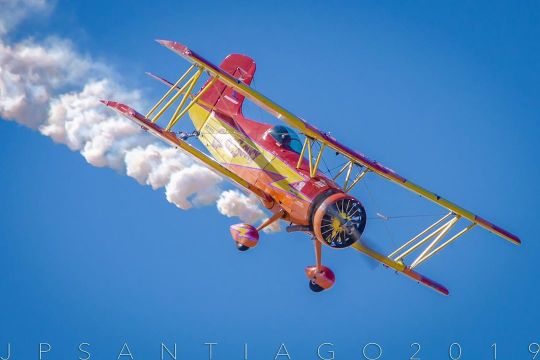
Gene Soucy’s “Showcat” was the product of a six-month rebuild and modification of a Grumman Ag-Cat crop duster. ⠀ ⠀ In 1958, two of Grumman’s preliminary design group members, Joe Lippert and Arthur Koch, saw a need for a rugged but extremely simple crop duster to replace the less than ideal wartime surplus Stearmans common in those days. They pitched their idea to Leroy Grumman, but the company was tied up with a lot of military business and Grumman told them they could do the Ag-Cat but only on a shoestring budget that didn’t take away resources from ongoing programs. ⠀ ⠀ They set up shop in an empty hangar and the entire engineering team consisted of 8 people. Craftsmen from the production lines volunteered to help in their free time and many Grumman technicians who were close to retirement but had skills dating to the 1920s and 1930s offered their services. At any one time, no more than 30 people worked on the Ag-Cat project!⠀ ⠀ Design and build of the prototype proceeded simultaneously! The close knit environment was a real throwback to Grumman’s early days. Joe Lippert built a mock up in his own garage and then brought ideas to the workshop the following day. In the evening, he modified the mockup based on the day’s decisions and work done. ⠀ ⠀ The first flight took place on 27 May 1957, just seven months after design/fabrication of the prototype, N10291, began! Lippert and Koch requested that all the workers who worked on the project bring their wives to the first flight- as many of them had worked additional hours on top of their existing jobs on the project, they thought that the wives should see "the other woman" in their husbands' lives!⠀ ⠀ November Aviation Photo Challenge | @kjdphoto1971 | #1119planes | “Biplane” | Day 27⠀ ⠀ #Avgeek #aviation #aircraft #planeporn #KAFW #AFW #AllianceAirport #FWAAS2017 #airport #planespotting #Grumman #AgCat #GeneSoucy #instagramaviation #aviationlovers #aviationphotography #instaaviation #aviationlovers #aviationphotography #flight #AvGeeksAero #AvGeekNation #AvgeekSchoolofKnowledge https://www.instagram.com/p/B5XxM95hF_I/?igshid=1g7cj8uqvarnf
#1119planes#avgeek#aviation#aircraft#planeporn#kafw#afw#allianceairport#fwaas2017#airport#planespotting#grumman#agcat#genesoucy#instagramaviation#aviationlovers#aviationphotography#instaaviation#flight#avgeeksaero#avgeeknation#avgeekschoolofknowledge
4 notes
·
View notes
Photo

Naturally, the USAF’s F-16 Viper Demo Team was going to make full use of the pyrotechnics display during the Vietnam combat search and rescue (CSAR) demo for their own photo shoot! Though the F-16’s official name is the Fighting Falcon, pilots and crews call the sleek jet the “Viper”. The name Fighting Falcon came from the USAF Academy’s mascot. Before the official name was selected, the early cadre of F-16 pilots at the jet’s first base, Hill AFB in Utah, had come up with some ideas, one of which was Viper, but the competitor to the F-16 in the Lightweight Fighter competition, the Northrop YF-17, was called the Cobra. That early group of F-16 pilots settled on the Viper name and at the time, the original Battlestar Galactica series was on TV and the space fighters on the Galactica were called Vipers. The YF-17 Cobra was later developed further when Northrop teamed up with McDonnell Douglas to create the F/A-18 Hornet. While the Fighting Falcon name made sense with the F-16 seen as a complement to the larger F-15 Eagle, the Viper nickname stuck. The Viper Demo Team is based at Shaw AFB in South Carolina and the pilot in my photo is the 2017-2018 demo pilot, Captain John “Rain” Waters. November Aviation Photo Challenge | @kjdphoto1971 | #1119planes | “Pyrotechnics” | Day 5 #Avgeek #aviation #aircraft #planeporn #KAFW #AFW #AllianceAirport #FWAAS2017 #AllianceAirShow2017 #airport #planespotting #Lockheed #F16 #FightingFalcon #ViperDemo #instagramaviation #aviationlovers #aviationphotography #mil_aviation_originals #instaaviation #aviationlovers #aviationphotography #flight #AvGeeksAero #AvGeekNation #AvgeekSchoolofKnowledge https://www.instagram.com/p/B4e6PUYh9cL/?igshid=kszz7t26j64h
#1119planes#avgeek#aviation#aircraft#planeporn#kafw#afw#allianceairport#fwaas2017#allianceairshow2017#airport#planespotting#lockheed#f16#fightingfalcon#viperdemo#instagramaviation#aviationlovers#aviationphotography#mil_aviation_originals#instaaviation#flight#avgeeksaero#avgeeknation#avgeekschoolofknowledge
5 notes
·
View notes
Photo

One of remaining active Beech Starships was on static display at the 2017 Fort Worth Alliance Air Show- two of them are based here in North Texas. One of the design elements of the Beech Starship that’s not too widely known is that the canards are variable geometry and on landing, they sweep forward to increase their effectiveness to trim out a nose down pitching moment when the Starship’s wing flaps are deployed. Much has been written about the why the revolutionary Beech Starship failed. It certainly was heavier than planned and that additional weight came from having to meet FAA requirements which at the time were new ground from a certification standpoint. Realistically the Starship didn’t need wing flaps- that added 800 lbs of weight for questionable gain, but flaps were needed for certification. Lowering the wing flaps shaved off only about 5 knots off the Starship’s stall speed. Adding to the weight was the need for the structure and mechanisms to sweep the canard forward when the wing flaps were deployed. Regardless, the Starship was a ground breaker and I’d even argue it blazed a regulatory pathway for composite aircraft of today like the Boeing 787 Dreamliner. It was the first certificated all glass cockpit/FMS aircraft. It was the first certificated all composite business aircraft. It was the first certificated tandem wing (canard) aircraft. It was the first certificated pusher aircraft. #Avgeek #aviation #aircraft #planeporn #KAFW #AFW #AllianceAirport #FWAAS2017 #AllianceAirShow2017 #airport #planespotting #Beech #Starship #N723SC #instagramaviation #aviationlovers #aviationphotography #instaaviation #aviationlovers #aviationphotography #flight #AvGeeksAero #AvGeekNation #AvgeekSchoolofKnowledge (at Fort Worth Alliance Airport) https://www.instagram.com/p/B3TIxQnBW2z/?igshid=1o819cwadbedb
#avgeek#aviation#aircraft#planeporn#kafw#afw#allianceairport#fwaas2017#allianceairshow2017#airport#planespotting#beech#starship#n723sc#instagramaviation#aviationlovers#aviationphotography#instaaviation#flight#avgeeksaero#avgeeknation#avgeekschoolofknowledge
7 notes
·
View notes
Photo

With 32 Lockheed C-130 Hercules transports that ranged in age from examples built in 1960 to as recently as 1997, the 32-strong Hercules transport fleet with the Royal Canadian Air Force was approaching the end of their service lives with heavy utilization over the years. In 2006, Canada announced a multi-billion dollar investment in airlift with an order for four Boeing C-17 Globemaster IIIs, 17 Lockheed C-130J-30 Hercules as well as a number of medium lift helicopters. The Hercules order was for the stretched -30 variant which was designated CC-130J in Canadian service. The first two were delivered in June 2010, six months ahead of schedule with the first Canadian Herks deploying to Afghanistan in December of that year. By May 2012, all 17 of the CC-130Js were delivered. With the Hercules order worth $1.4 billion, included were nearly $900 million in industrial offsets benefiting Canadian industry. Compared to the older Hercules models flown by the Canadians, the CC-130Js are more capable and require only three crew (two pilots and a loadmaster) compared to five with the older aircraft. The new Hercules transports are assigned to 8 Wing at CFB Trenton, Ontario. #Avgeek #aviation #aircraft #planeporn #KAFW #AFW #AllianceAirport #FWAAS2017 #AllianceAirShow2017 #airport #planespotting #Lockheed #CC130J #Hercules #RCAF #instagramaviation #aviationlovers #aviationphotography #mil_aviation_originals #instaaviation #aviationlovers #aviationphotography #flight #AvGeeksAero #AvGeekNation #AvgeekSchoolofKnowledge (at Fort Worth Alliance Airport) https://www.instagram.com/p/B3TF0sEBQWx/?igshid=1j5esy74itr9e
#avgeek#aviation#aircraft#planeporn#kafw#afw#allianceairport#fwaas2017#allianceairshow2017#airport#planespotting#lockheed#cc130j#hercules#rcaf#instagramaviation#aviationlovers#aviationphotography#mil_aviation_originals#instaaviation#flight#avgeeksaero#avgeeknation#avgeekschoolofknowledge
3 notes
·
View notes
Photo

Blue Angel 5 and 6 do an impeccable Calypso Pass- while the Thunderbirds do the same maneuver, the Blues do it approach configuration with everything hanging out. Or sticking up if you’re Blue Angel 5! #Avgeek #aviation #aircraft #planeporn #KAFW #AFW #AllianceAirport #FWAAS2017 #AllianceAirShow2017 #airport #planespotting #McDonnellDouglas #Boeing #FA18 #Hornet #BlueAngels #instagramaviation #aviationlovers #aviationphotography #mil_aviation_originals #instaaviation #aviationlovers #aviationphotography #flight #AvGeeksAero #AvGeekNation #AvgeekSchoolofKnowledge https://www.instagram.com/sentinelchicken/p/BxESpVylA48/?igshid=q80qcas9sif1
#avgeek#aviation#aircraft#planeporn#kafw#afw#allianceairport#fwaas2017#allianceairshow2017#airport#planespotting#mcdonnelldouglas#boeing#fa18#hornet#blueangels#instagramaviation#aviationlovers#aviationphotography#mil_aviation_originals#instaaviation#flight#avgeeksaero#avgeeknation#avgeekschoolofknowledge
18 notes
·
View notes
Photo

The Douglas AC-47 Spooky gunship was the grand-daddy of a whole unique class of combat aircraft that came into existence in Vietnam. The first AC-47 gunships were converted at Bien Hoa AB in-theater with conversion kits created by the Air Force’s Aeronautical Systems Division. Two aircraft were converted as a proof of concept with three 7.62mm Miniguns, a Mark 20 Mod 4 gunsight from A-1 Skyraider mounted on the pilot’s left cockpit window, VHF, UHF, and FM radios, TACAN equipment for navigation, IFF gear, 45 flares, each producing 20,000 candlepower of illumination and over 24,000 rounds of ammunition for the Miniguns. The new gunships were designated FC-47 (FC for “Fighter, Cargo). Aeronautical Systems Division crews flew the first two FC-47s on 54 combat missions where they were decisive in breaking Viet Cong night assaults. Not long after those first two prototype FC-47s were flying combat missions, the fighter pilots on the command staff of Seventh Air Force and the Pacific Air Forces which were in command of USAF assets in Southeast Asia, heard about the FC-47 designation and nearly lost their minds over aircraft that were built during World War II with “F” designators. In the interests of keeping the peace and avoiding an inter-service controversy, the FC-47 was redesignated the AC-47. #Avgeek #aviation #aircraft #planeporn #KAFW #AFW #AllianceAirport #FWAAS2017 #AllianceAirShow2017 #airport #planespotting #instagramaviation #aviationlovers #aviationphotography #instaaviation #aviationlovers #aviationphotography #flight #Douglas #DC3 #C47 #Skytrain #Dakota #AC47 #Spooky #PufftheMagicDragon #instagramaviation #igaviationcontest #Avgeekery #AvgeekSchoolofKnowledge #mil_aviation_originals #USAF (at Fort Worth Alliance Airport) https://www.instagram.com/p/Bnm40SYgRps/?utm_source=ig_tumblr_share&igshid=1h6jjfvbaafbm
#avgeek#aviation#aircraft#planeporn#kafw#afw#allianceairport#fwaas2017#allianceairshow2017#airport#planespotting#instagramaviation#aviationlovers#aviationphotography#instaaviation#flight#douglas#dc3#c47#skytrain#dakota#ac47#spooky#puffthemagicdragon#igaviationcontest#avgeekery#avgeekschoolofknowledge#mil_aviation_originals#usaf
34 notes
·
View notes
Photo

The Blue Angels *tight* diamond formation from the 2017 Fort Worth Alliance Air Show. This never fails to impress with their minimal separation that’s publicly stated to be 18 inches apart but I’ve read stories that they can get as close as six inches apart! If you look close, you can see both Blue Angel 2 and Blue Angel 3 looking towards the Boss’s aircraft (Blue Angel 1) as they fix on a point of reference on the Boss’s aircraft to help hold their position in the formation. #Avgeek #aviation #aircraft #planeporn #KAFW #AFW #AllianceAirport #FWAAS2017 #AllianceAirShow2017 #airport #planespotting #McDonnellDouglas #Boeing #FA18 #Hornet #BlueAngels #instagramaviation #aviationlovers #aviationphotography #Avgeekery #mil_aviation_originals #instaaviation #aviationlovers #aviationphotography #flight #AvgeekSchoolofKnowledge (at Fort Worth Alliance Airport) https://www.instagram.com/p/BpnvJxylerc/?utm_source=ig_tumblr_share&igshid=1tj0leuzc7acr
#avgeek#aviation#aircraft#planeporn#kafw#afw#allianceairport#fwaas2017#allianceairshow2017#airport#planespotting#mcdonnelldouglas#boeing#fa18#hornet#blueangels#instagramaviation#aviationlovers#aviationphotography#avgeekery#mil_aviation_originals#instaaviation#flight#avgeekschoolofknowledge
9 notes
·
View notes
Photo

Aerobatic pilot Sean D. Tucker's signature red Oracle Challenger III biplane weighs in at only 1200 lbs but has a souped up 400 hp Lycoming engine! The high power-to-weight ratio makes his biplane one of the most powerful aerobatic piston aircraft on the air show circuit. At the end of each air show season, the Challenger III is near completely disassembled and scrutinized in a tear down and reassembly that takes over 2000 hours and costs over $200K. But when done, Sean gets a literally brand new aircraft that he has to familiarize himself with again as it will likely fly just a bit differently after each rebuild. He’ll easily spend 90 flights before the start of the season practicing his routines and learning the quirks of his rebuilt aircraft. #Avgeek #aviation #aircraft #planeporn #KAFW #AFW #AllianceAirport #FWAAS2017 #AllianceAirShow2017 #airport #planespotting #Oracle #TeamOracle #OracleChallengerIII #SeanDTucker #instagramaviation #aviationlovers #aviationphotography #Avgeekery #instaaviation #aviationlovers #aviationphotography #flight #blackandwhitephotography #blackandwhitephoto #blackandwhite#AvgeekSchoolofKnowledge (at Fort Worth Alliance Airport)
#oraclechallengeriii#avgeekschoolofknowledge#allianceairport#instaaviation#aviationphotography#fwaas2017#oracle#blackandwhite#flight#aircraft#airport#aviation#allianceairshow2017#afw#blackandwhitephoto#instagramaviation#blackandwhitephotography#avgeek#avgeekery#planeporn#seandtucker#teamoracle#planespotting#aviationlovers#kafw
12 notes
·
View notes
Photo

Naturally, the USAF’s F-16 Viper Demo Team was going to make full use of the pyrotechnics display during the Vietnam combat search and rescue (CSAR) demo for their own photo shoot! Though the F-16’s official name is the Fighting Falcon, pilots and crews call the sleek jet the “Viper”. The name Fighting Falcon came from the USAF Academy’s mascot. Before the official name was selected, the early cadre of F-16 pilots at the jet’s first base, Hill AFB in Utah, had come up with some ideas, one of which was Viper, but the competitor to the F-16 in the Lightweight Fighter competition, the Northrop YF-17, was called the Cobra. That early group of F-16 pilots settled on the Viper name and at the time, the original Battlestar Galactica series was on TV and the space fighters on the Galactica were called Vipers. While the Fighting Falcon name made sense with the F-16 seen as a complement to the larger F-15 Eagle, the Viper nickname stuck. The Viper Demo Team is based at Shaw AFB in South Carolina and the pilot in my photo is the 2017-2018 demo pilot, Captain John “Rain” Waters. #Avgeek #aviation #aircraft #planeporn #KAFW #AFW #AllianceAirport #FWAAS2017 #AllianceAirShow2017 #airport #planespotting #instagramaviation #aviationlovers #aviationphotography #instaaviation #aviationlovers #aviationphotography #flight #LockheedMartin #Lockheed #F16 #FightingFalcon #Viper #ViperDemoTeam #instagramaviation #igaviationcontest #Avgeekery #AvgeekSchoolofKnowledge #mil_aviation_originals #USAF #AirCombatCommand (at Fort Worth Alliance Airport)
#allianceairshow2017#viperdemoteam#flight#avgeekery#allianceairport#afw#usaf#aviationlovers#aircombatcommand#lockheedmartin#viper#fwaas2017#avgeekschoolofknowledge#avgeek#aviationphotography#fightingfalcon#igaviationcontest#f16#kafw#instaaviation#planespotting#aircraft#lockheed#planeporn#aviation#airport#instagramaviation#mil_aviation_originals
8 notes
·
View notes
Photo

One of the Royal Canadian Air Force’s Lockheed CC-130Js sits in the predawn light at Fort Worth Alliance Airport this past October. Canada got the first of seventeen CC-130Js (Canadian designation of the C-130J-30 Hercules) on 4 June 2010 and all are based with the 8 Wing at CFB Trenton, Ontario. The deliveries were completed in April 2012 and were part of an order that included C$1.4 billion in Canadian industrial offsets. Lockheed has about 900 employees in Canada, mostly devoted to the support of the CC-130J. 436 Squadron “Tusker” operates the CC-130J under the aegis of 8 Wing, replacing older C-130E aircraft. 436 Squadron was originally established in 1944 in Gujrat, India, to support RAF operations in the China-Burma-India (CBI) theater with Douglas C-47 Dakotas. The squadron’s badge reflects its origins in India. In the CBI, 436 Squadron was part of the Combat Cargo Task Force, operating with both RAF and USAAF transport units in an inter-Allied cooperative effort that would later shape inter-Allied cooperation in NATO during the early days of the Cold War. I believe 436 Squadron was the last Canadian squadron to come home at the end of the Second World War. #Avgeek #aviation #aircraft #planeporn #KAFW #AFW #AllianceAirport #FWAAS2017 #AllianceAirShow2017 #airport #planespotting #Lockheed #C130 #CC130J #SuperHercules #Hercules #RCAF #CanadianForces #8Wing #instagramaviation #aviationlovers #aviationphotography #Avgeekery #mil_aviation_originals #instaaviation #aviationlovers #aviationphotography #flight #AvgeekSchoolofKnowledge (at Fort Worth Alliance Airport)
#afw#hercules#8wing#aircraft#aviationphotography#rcaf#cc130j#aviation#fwaas2017#mil_aviation_originals#avgeek#airport#c130#allianceairshow2017#instagramaviation#planespotting#superhercules#flight#allianceairport#planeporn#aviationlovers#lockheed#canadianforces#kafw#avgeekschoolofknowledge#avgeekery#instaaviation
4 notes
·
View notes